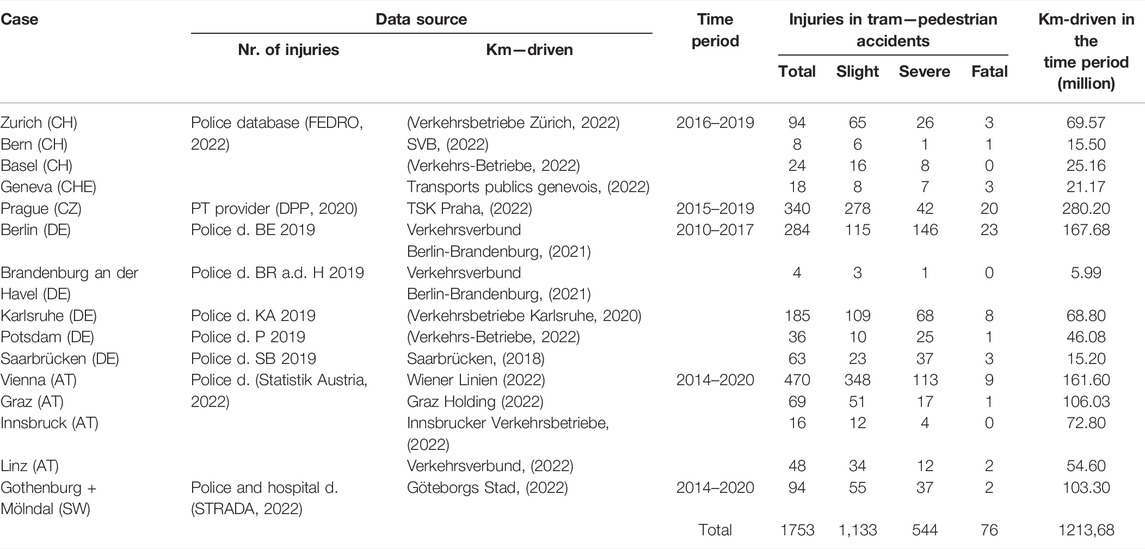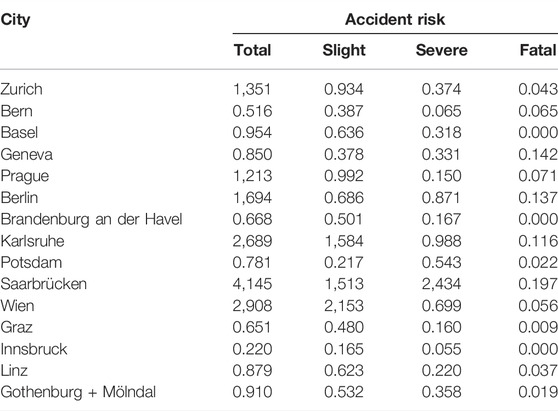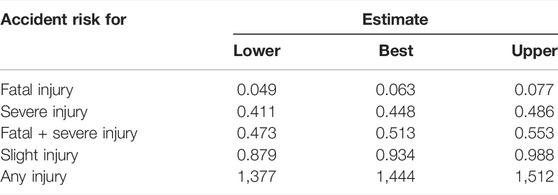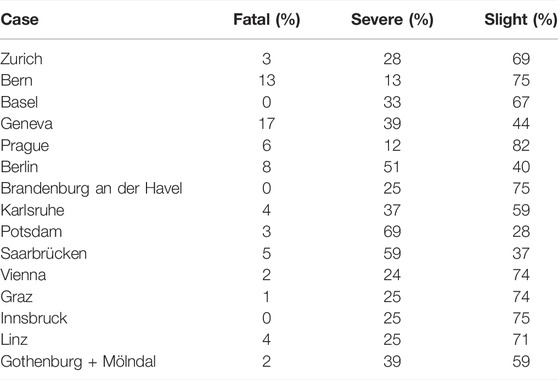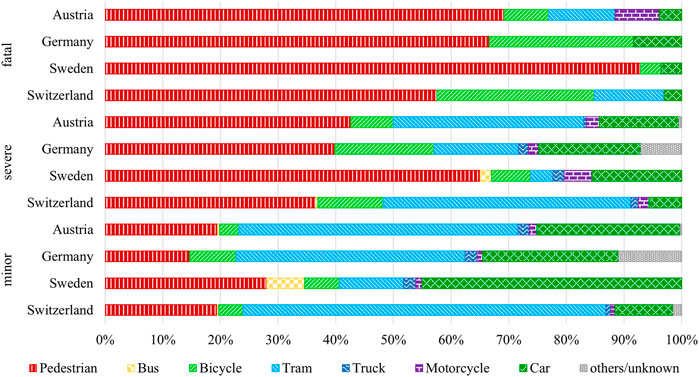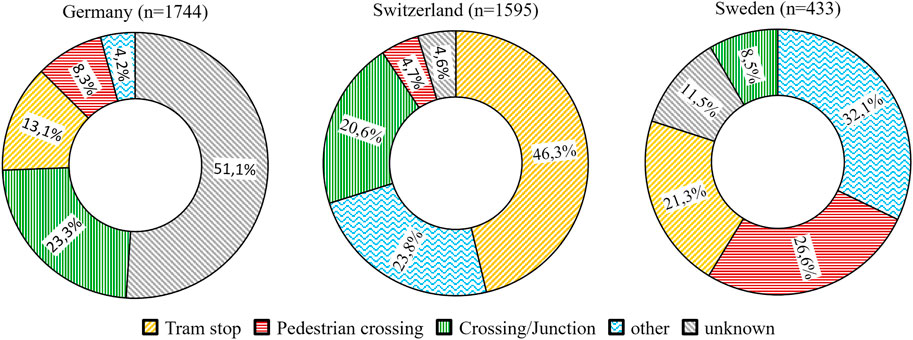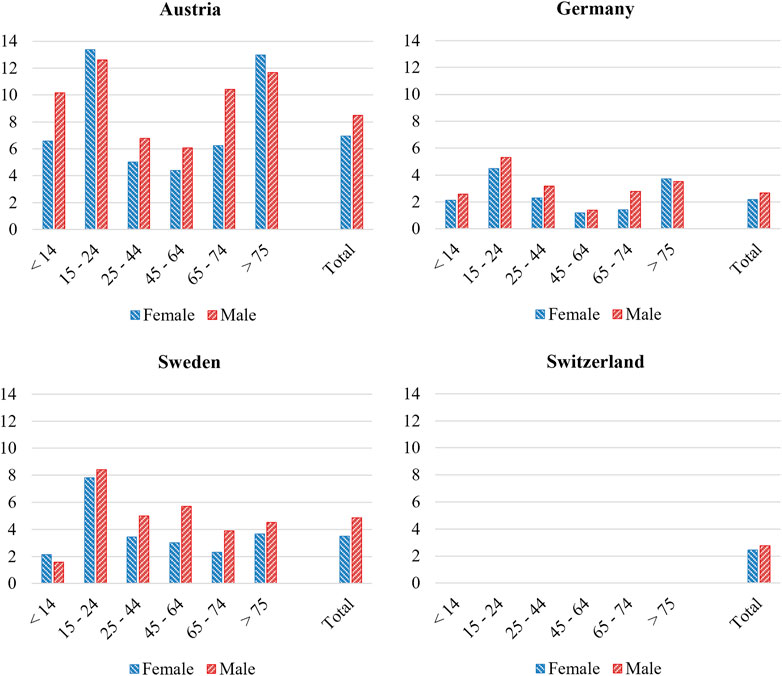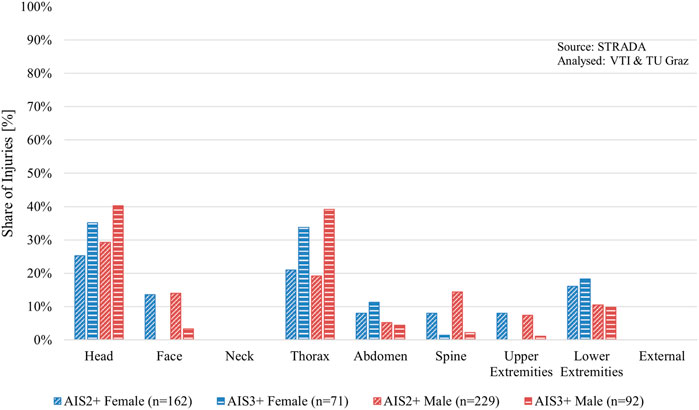- 1System Engineering, Siemens Mobility Austria GmbH, Vienna, Austria
- 2Swedish National Road and Transport Research Institute, VTI, Linköping, Sweden
- 3Vehicle Safety Institute, Graz University of Technology, Graz, Austria
- 4Institute of Transport Economics, TØI, Oslo, Norway
- 5Accident Research and Prevention, AXA, Winterthur, Switzerland
- 6Vehicle Safety Division, Department of Mechanics and Maritime Science, Chalmers University, Gothenburg, Sweden
To improve mobility in cities in line with environmental goals, in urban traffic, trams represent an increasingly important means of transport. Due to the close interaction with other road users, this makes collisions with trams fairly frequent. This study has investigated accidents between trams and vulnerable road users resulting in personal injury, aimed at identifying priorities for simulating collisions between trams and pedestrians to assess passive safety measures. Tram accident data collection established throughout Europe from multiple sources and with varying degree of details, have been combined and analysed. These analyses comprise risk assessments per km-driven and general tram accident partner and site type evaluations, with more detailed analyses on accident site distance to the closest tram stop and injured body regions, respectively. In total, 7,535 tram-pedestrian accident resulting in 8,802 pedestrian injuries, collected in the year 2000–2021, was analysed. Accident risk ranges from 0.934 accidents per number of tram (million) km-driven, for slight injuries to 0.063 for fatal injuries. Pedestrians represent a large proportion of tram accident collision partners, especially for severe and fatal accidents. In accidents between trams and pedestrians, 3% of reported injuries are fatal, 23% severe and 74% minor. Generally, low-speed accidents close to tram stops often leading to minor injuries were observed to be of significant importance (<20m to the GPS location of a stop). Analysis of accidents was done bases on gender of the pedestrian showing overall similar involvements in accident with slight difference for various age groups and sites. Regardless of injury severity, the most frequently injured body region in accidents involving a tram is the head. Likewise, injuries sustained to the thorax, especially for higher injury severities are of high relevance, followed by injuries to the lower extremities. Based on this study, recommendations for developing reasonable tram-pedestrian accident scenarios for virtual testing can be derived for further optimisation of pedestrian safety of trams.
Introduction
Trams as an integral part of (sub) urban mass public transport services are of significant importance in many cities around the world. While the reopening of tramway lines has been concentrated to western Europe (such as France, Spain, Sweden, and the United Kingdom), in Germany and eastern Europe, the existing systems continue to be expanded and modernised (MVG, 2009). The renaissance of trams goes hand in hand with efforts to improve mobility, accessibility and reduce environmental issues in urban areas (Guerrieri, 2018).
Currently, trams run in 204 cities in Europe with a continuously increasing tram network length by almost 4% (420 km) in Europe between 2015 and 2018 (UIC: International union of Railways, 2009). Obviously, increased number of trams in the cities means that the interaction between trams and other road users are more frequent than ever. Thus, ensuring safety and mitigating tram related accidents is a major concern in the design, operation and development of tram systems (Naznin et al, 2016a), which requires reliable data and first-rate safety knowledge. Current knowledge is almost entirely based on analyses of reported accident data (Naznin et al., 2017), which shortcomings are well-known, such as lack of information on human related accident contributory factors (Naznin et al., 2017) and a high level of underreporting, especially for less severe accidents (Budzynski et al., 2019b). However, despite these limitations, data on accidents are crucial for understanding the safety trends and recognising several accident risk factors.
Accident Data
In 2015, only one country (France) in Europe had a specific tram accident database on a national scale (COST, 2015) while such database did not exist on the European level. Some countries, such as Germany or Switzerland, included tram accidents in their national road traffic accidents databases, operated by police. Typically, on a city level, tram operators collect tram accident data, which are often publicly available, i.e., in form of annual reports, and therefore the level of detail is deficient.
Budzynski et al. (2019a) have categorised tram accidents into four groups: 1) involving a single tram, 2) involving other trams, 3) involving other road users, and 4) others, i.e., accidents between cars and pedestrians near tram stops. In our study, we have focussed on accidents involving other road users, more specifically pedestrians, as they present a particular challenge due to their vulnerability in traffic (Guerrieri, 2018).
Overall accident risk data indicate that the tramway transportation systems are relatively safe when compared to other modes of transport (Guerrieri, 2018). However, injury severity for pedestrians is higher in tram-pedestrian accidents than in accidents with other motor vehicles. This particular higher injury risk has been documented in a number of studies, such as Hedelin et al., 2002; Margaritis, 2007; Naznin et al., 2016b; Chevalier et al., 2019, and Gaca and Franek, 2021.
Occurrence of Tram-Pedestrian Accidents
The conflicts with other users of public space, in relation to their behaviour and their perception of risk are recognised as the primary cause of tram accidents in the COST report TU 1,103 (COST, 2015). Human factors relate to the issues of risk perception, expectancy, inattention and risk behaviour. Lack of danger awareness by tram drivers, and inappropriate reactions of other road users played a major role in all fatal accidents analysed by Margaritis (2007). Castanier et al., 2012 demonstrated that road users have little awareness of accident risks with trams and young pedestrians in particular, perceive a lower risk for themselves than for others. According to Kruszyna and Rychlewski (2013), an approaching tram affects pedestrian behaviour in such way that they behave unsafely, such as violating a red light. A common accident type identified by Sagberg and Sætermo (1997) is pedestrians stepping into the street, often against a red light, without noticing an approaching tram. Furthermore, being under the influence of alcohol is an important factor, as intoxicated pedestrians were frequently identified as victims in tram-pedestrian accidents by Hedelin et al. (1996). The road safety campaign website “Don’t jump under my wheels” that was launched in Prague (CZ) in 2020, describes that 25% of pedestrians involved in tram-pedestrian accidents in Prague (in period 2016–2019) were foreigners. It suggests that unfamiliarity with tram traffic by some foreigners (Prague has one of the most extensive tram networks in the world) might play a role in accident occurrence, as might very silent tram vehicles. Furthermore, pedestrian inattention (particularly looking at a mobile device) is mentioned as the most common contributory factor with regard to accidents in Prague (DPP–Prague Public Transit Company, 2020). although tram driver related accidents are important as well. Naweed and Rose (2015) revealed three major topics relating to causes of accidents from the point of view of tram drivers: situation awareness, time pressure, and organisational behaviour. Tram driver focus groups conducted by Naznin et al. (2017) identified factors such as pressure of keeping to the timetable, maintaining constant concentration, predicting other road users’ behaviour, operational constraints of trams as well as fatigue from workload.
Infrastructure factors, especially tram stop design was found a key accident risk factor by Naznin et al. (2016a) and Sagberg and Sætermo (1997). In Melbourne, for instance, curbside stops have been identified as a major passenger safety concern (Currie and Shalaby, 2007). According to Budzynski et al. (2019a), the biggest risk is at tram stops forming part of pavements where pedestrians have to cross the road as the tram approaches the stop and when tram stops are at signalised junction exits. Design of road intersections plays a significant role, as well (Guirrieri, 2018).
Vehicle factors, such as low floor and older trams, were reported by Naznin et al. (2016b). Sagberg and Sætermo (1997) found that pedestrians are often crossing too close to the front of a stationary tram, that the driver is unable to notice them due to blind spots. Technical factors, i.e., failure of the tram door safety system and the braking system, and the deceleration performance of trams, which largely differs to other vehicles, (the braking efficiency of trams generally being lower compared to buses, for instance), were also identified as an accident risk factor in the in-depth accident study by Margaritis (2007).
Severity of Tram-Pedestrian Accidents
The injuries sustained by a pedestrian being hit by a tram can go through several phases—initially from the impact of the tram, subsequently by falling onto the ground and lastly, potentially, being run over by the tram. The most serious injuries occur when pedestrians are run over (Hedelin et al., 1996). In general, the severity of tram-pedestrian accidents is primarily affected by vehicle related factors, especially by the mass difference between a tram and a human (a tram vehicle can weigh up to 50 tonnes) and ergonomics and stiffness of the vehicle’s front (Hedelin et al., 1996; Grzebieta and Rechnitzer, 2000; Margaritis, 2007; COST, 2015; Gaca and Franek, 2021). A simulation study by Chevalier et al., 2019 on the effects on pedestrian injury by tram front-end shape, showed that the injury risk is more severe for the head than any other body region. Špirk et al. (2021) stated that the most prominent part of the tram front-end responsible for the level of head injury is the windshield. Margaritis (2007) discusses the function of the front under-run protection—he notes that it is more effective at low tram speeds. The injury severity is further affected by the secondary impact, i.e., the physical infrastructure or railway equipment, respectively, the pedestrian hits following the primary impact (Gaca and Franek, 2021). Human factors, such as age, might play a role as well, as exclusively elderly people were found to be involved in fatal tram accidents investigated by Currie et al., 2011.
The recently published Technical Recommendation 17,420 (Technical Committee CEN/TC, 2019) defines pedestrian tram front design safety requirements for the first time, mainly based on geometrical guidelines. Deeper knowledge of relevant tram-pedestrian accident parameters and advanced simulation methods will also lead to improved standardisation and tram designs in future.
Safety management requires the most recent and valid knowledge on accident risks, accident locations, characteristics of pedestrians involved, tram characteristics, etc. This study is contributing to safety management by answering the following research questions on a European level:
• What is the most relevant vulnerable group of road users in tram accidents?
• What is the accident risk for pedestrian to tram accidents?
• Accident locations for pedestrian to tram accidents, e.g., near tram stops?
• Which collision speeds can be observed in pedestrian to tram accidents?
• Which injuries can be observed in pedestrian to tram accidents, e.g., age and gender?
This study aims to derive representative boundary conditions for simulation scenarios to evaluate safety measures for vulnerable road user (VRU) protection of novel trams by answering these questions above. Priorities will be defined based on field data and the derived boundary conditions will be used as input for simulation scenarios. Within the simulations, the injury risk of baseline systems compared to enhanced ones can be compared and finally cost benefit analyses (CBA) can be performed to support decision-making on the introduction of new safety systems for trams.
Materials and Methods
Accident Risk Analysis Data
Accident risk quantifies the level of safety relative to the amount of an exposure. The terms risk and exposure should be defined within the context of the issue studied (Hakkert and Braimaister, 2002). In this study, we consider the risk as the probability of pedestrian injury within km-driven by trams. Regardless its limitations (not capturing the respective pedestrian volumes) km-driven is chosen as exposure measure by a transport mode because of its common availability (Elvik, 2015). We have calculated such risk as the number of injured pedestrians in tram-pedestrian accidents (separately for fatal, severe, slight, fatal + severe and all injuries), divided by the amount of km-driven by trams in each respective period. Such calculations are easy to understand and interpret (Bjørnskau and Ingebrigtsen, 2015).
The accident data (annual number of fatally, severely and slightly injured pedestrians in tram-pedestrian accidents) and data on exposure (km-driven) were collected and will be referred to as “cases” throughout this study. The data span over the period 2014–2020, with minor timing differences but a minimum period of 4 years in each case. Table 1 shows the data for all these cases - note that for Sweden, each case contains several cities.
The accident risk for each severity level was calculated separately for each case. To obtain the best estimates of the risks, data from all cases were counted and the best estimates were calculated as the total number of accidents for a specific severity level, divided by the total number of km-driven by each tram line. To obtain the upper and lower values at 95% confidence level for the best estimates, we have assumed that injuries and crashes are Poisson-distributed. The standard deviation is then equal to the square root of the number of accidents. A 95% confidence interval is obtained by multiplying the standard deviation by 1.96. The upper and lower 95% estimate of the number of crashes = number of accidents ± (1.96 * √the number of accidents).
Furthermore, the distribution of injury severity levels in tram-pedestrian accidents, was calculated separately for each case and together for all cases.
Accident Scenarios
To obtain an extensive picture, the analysis of tram accident scenarios was based on accident data of more than 260 public transport system operators, statistics institutes, ministries/authorities, police, hospitals, rescue organisations, insurance companies and tramway manufacturers. Data sets from several countries including Austria, Germany, Sweden and Switzerland have been collected in a database, free of any personal data of the involved individuals. Furthermore, metadata from other European countries were collected, however due to their quantity and quality these were not considered in the overall evaluation. A full survey was carried out for Austria, Sweden and Switzerland, as well as a partial survey for Germany. In total, the following statistics are based on 7,535 accidents with at least one tram involved during the period 2000 to 2021 and 8,802 injuries/fatalities sustained by persons in the above mentioned countries.
Tram Accident Data From Austria
Vienna’s tram network, with a total length of 175.6 km (Wiener Wiener Linien, 2020), is one of the longest and the third busiest tram network in the world (UITP: International Association of Public Transport, 2019). By law in Austria, all accidents involving personal injury must be reported by the police (Bundesgesetzblatt, BGBI, 2017) and subsequently transmitted to the federal statistical office “STATISTIK AUSTRIA”. Accident reports contain information on the accident type, participants, injury severities, as well as geographical location. Thus, a full statistical survey is made available, including for tram-pedestrian accidents. The relevance of the tram network, as well as the available accident data make Vienna a particularly interesting source for investigating tram-pedestrian accidents. During the period 2014–2020, 470 accidents were reported in Vienna, which have been further analysed in this paper, with respect to severity, type and site.
Tram Accident Data From Germany
The Federal Statistical Office, the German counterpart to Statistics Austria, only provides a statistical overview, which was only used to check whether the data otherwise obtained from Germany is representative. The Federal Statistical Office obtains the data from the police. In order to obtain individual data, the individual police headquarters of the federal states were contacted. The data collection procedure of each police station is similar, irrespective of federal state. However, the police headquarters only partially released the data, which meant that not all data sets met the requirements. Data from the police headquarters in Baden-Württemberg, Lower Saxony, Brandenburg West, Middle Franconia, Bavaria, Berlin and Saarland were made available. The data cover 31.4% of the total number of accidents and 16.5% of the network length in Germany (Federal Statistical Office of Germany, 2021). Thus, unlike the Austrian, Swedish and Swiss data, this is a partial survey. Trams are operated in over 50 German cities, with a total network length of over 3,100 km (UIC: International union of Railways, 2009).
Tram Accident Data From Sweden
The Swedish Traffic Accident Data Acquisition (STRADA) database holds information on road traffic accidents occurring on public roads in Sweden. The information regarding these accidents stem from two sources: the police and emergency hospital departments. As of 2016, all emergency hospital departments in Sweden are included, allowing hospital reported data to be deemed nationally representative (Swedish Government Offices, 1965; Mattsson and Ungerbäck, 2013). Hospital reports included in STRADA normally provide a number of parameters regarding accident circumstances, i.e., a brief description of the accident, accident type and location of the accident. Also included is personal information about the patient, e.g., age and gender, together with a full injury diagnosis classified according to the 2005 AIS scale (AAAM, 2005). For example, data from the police, include a description of the crash, information about involved vehicles and the road environment. The STRADA database is described in more detail in (Howard and Linder, 2014; Yamazaki, 2018).
In this study, all crashes between 1st January 2000 until 1st November 2021 involving a tram, resulting in personal injury reported by the police and/or emergency hospital department, were included (N = 1,552). As the specific focus of the present study is pedestrians, additional data of injuries were included from the 259 injured pedestrians reported by emergency hospital departments. Of these, detailed AIS 2005 codes were available for 176 injured pedestrians resulting in 896 individual injuries.
Tram Accident Data From Switzerland
The data from Switzerland were provided by the Federal Office of Transport. In contrast to the above mentioned data sources, these data come directly from the transport operators, who are obliged to report traffic accidents involving personal injury. As in the case of Austria and Sweden, these data are also a full statistical survey. Trams are operated in the cities of Basel, Bern, Geneva, Lausanne, Neuchâtel and Zurich (Verkehrsbetriebe Zürich, 2022).
Accident Location Analysis in the Austrian Database
In comparison to other national statistics (German, Swedish, Swiss), the Austrian data does not disclose whether a tram-pedestrian accident has occurred close to a tram stop. Furthermore, in-depth data recording the collision speeds of the trams is unavailable. To overcome this drawback, the distance between each documented accident to the nearest tram stop has been evaluated, by matching its geo location with the tram network.
A typical modern tram accelerates and decelerates, respectively, at approximately 1 m/s2 in regular service (Peng et al., 2018). Assuming this speed the constant acceleration/deceleration from the stop to the accident location, the respective impact speed can be estimated for each accident. To avoid unrealistic high impact speeds at accident locations far away from a stop, speed limits for associated edges have been retrieved from the OSM tram network to cap the maximum speed.
To determine tram stop coordinates, data from Vienna’s public transport provider “Wiener Linien” (BMDW, 2018a; BMDW, 2018b, Wiener Linien 2021) was used. The data contains geo information, as well as associated travel routes, which are dependent on time of day and public holidays amongst other factors. In total, 978 stops have been determined. Although a reconstruction of the tram network is possible in principle, a network of that kind would still lack detailed track information, i.e., curvatures or speed limits on a particular track section. In order to deal with this issue, data from OpenStreetMap (OSM), the largest Volunteered Geographic Information (VGI) project, was used additionally, please see Figure 1. OSM is continuously updated and extended and grants users free access to an editable map of the world (Corcoran et.al., 2013). Data can either be viewed online (openstreetmap.com), or downloaded through programming interfaces, such as OSMnx (Boeing, 2017), which was used for this study. For retrieving the OSM information, “Vienna, Austria” was selected as location and as an additional filter: “railway”∼“tram|rail” was used. Although data quality is one of the main concerns (Barron et al., 2014, the quality which is quite accurate for many countries, depends on the maintainers in specific areas (Girres and Touya, 2010; Haklay, 2010), which for certain locations are also updated through federal funded projects (Hakley, 2014). According to the OSM wiki, the Vienna tram track network is almost complete (OSM Wiki, 2020). The extracted tram track network of Vienna consists of 4,721 nodes and 12,540 edges.
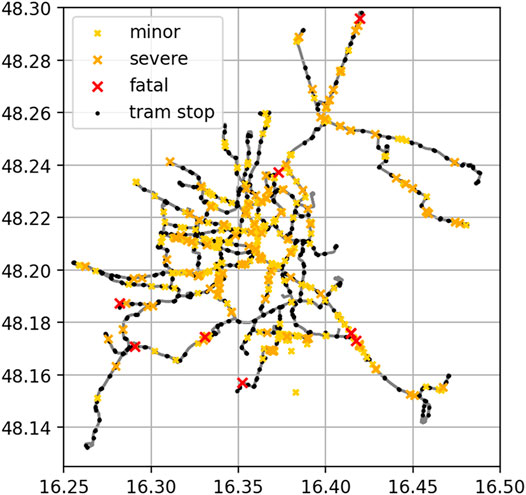
FIGURE 1. Vienna OSM tram track network, with the associated 933 tram stops and the location of accidents.
The retrieved tram stop locations have further been fused with the OSM tram track network. For each tram stop, a corresponding node or edge, respectively, has been determined in the graph by calculating the respective minimum Euclidean distance. The median distance is 0.14 m with 933 of 978 stops, being at a distance of less than 5 m between their respective retrieved tram stop location and the tram track according to OSM, which indicates a good correspondence between the location of the stops and the actual network. Further analysis shows that 933 stops have been used to determine distances between the accident sites and the closest stops. Similarly, distances between the accident locations and the tram track network have been retrieved. Here, a median distance of 1.76 m has been observed (90 percentile of 15.22 m and a 95 percentile of 23 m) between the accident location and the tram network. For the further analysis, 20 m has been used as a cut off to omit inaccurate mapping, which finally resulted in 442 of 470 evaluable accidents.
Data Analysis
Accident risk data has been collected for Austria, the Czech Republic, Sweden and Switzerland. Of these five countries, the largest tram networks in the following cities were studied: Graz, Innsbruck, Linz, Vienna, Prague, Gothenburg, Mölndal, Zurich, Bern, Basel, Geneva, totalling 1753 accidents recorded between; 2016 and 2019 (Czech Republic, Switzerland) and 2016 and 2020 (Austria, Sweden), as listed in Table 1.
A total of 7,535 accidents with reference to road use and severity were studied, which had occurred in the following four countries: Austria, Germany and Switzerland between 2010 and 2017 and in Sweden between 2000 and 2021. In the same countries and during the same period, a survey of injured persons by road use and severity was carried out, comprising a total of 8,802 injured persons.
The accident site analysis is based on data from Germany (2010–2017), Switzerland (2010–2017) and Sweden (2000–2021). In addition, data from accidents that had occurred in Vienna, Austria, between 2014 and 2020 were also used.
Data on age and gender of the injured pedestrians were analysed for Austria, Germany, Sweden and Switzerland. Again, data from Austria, Germany and Switzerland are from the time period 2010–2017, while data from Sweden was available for the period 2000 and 2021. Demographic data of Austria, Switzerland and Sweden stem from Eurostat (European Union, 2021), demographic data of observed regions in Germany of the federal statistical office of Germany (Federal Statistical Office of Germany, 2021).
For the detailed injury analysis, only data from Sweden was available (2000–2021), as detailed AIS codes have not been recorded in any of the other databases for tram accidents. The analysis of injuries is based on AIS 2005.
Results
Accident Risk
The results for accident risks are provided in Table 2 and Table 3. Table 2 contains the risk values for each city, while Table 3 provides lower, best and upper estimates of risks calculated from all cases together.
Regarding the severity distribution in tram-pedestrian accidents, the aggregated data from these cases show that 3% of reported injuries are fatal, 23% severe and 74% slight. There are obvious regional differences in the cases–see Table 4.
Injured People Classified by Road Use and Severity
Most of the accidents analysed in this study led to minor injuries (80%), please see Table 2 in the Appendix, followed by severe injuries (16%). With an absolute number of 123 fatal injuries, these account for only 1.4% of all accidents investigated in this study.
Figure 2 shows the distribution of injured people in tram accidents classified by severity and road use across Austria, Germany, Sweden and Switzerland. Road user fatalities occur most likely to pedestrians (70.1%) and cyclists (17%), who together represent the most vulnerable group (87.1%) of road users. Pedestrians generally form the largest group in the severity category “severe” (41.9%). Therefore, the design of pedestrian-friendly trams is highly relevant. Also of interest is the individual severity results for pedestrians across the considered countries, which tendencies are similar.
Injured People by Accident Site
Typical tram vs. pedestrian accident sites have been compared for Germany, Sweden and Switzerland, please see Figure 3. In Germany, accidents at crossings, junctions and roundabouts (23%) are commonly observed, yet there is also a large number of accidents not explicitly disclosing each respective site. Accidents at tram stops account for approximately 13% of all accidents in Germany, which in comparison to data from Sweden and Switzerland seems low. In Switzerland most of the accidents happen at or near a tram stop (46.3%) which indicates relatively low tram impact speeds. Also in Sweden, accidents at tram stops are the third most common type of accident after accidents on pedestrian crossings. In the STRADA accident database, “pedestrian crossing” is a subcategory of all accidents in general, which is summarised in Table 4 of the appendix. In the order of a quarter (26.6%) of the accidents involving a pedestrian and a tram in Sweden occur at a zebra crossing.
For Vienna, accident sites and types have been re-evaluated by incorporating distances between tram stops and accidents. Accidents which happened within a distance of 20 m of the accident location, were reclassified “tram stop” accidents, the detailed classification, i.e., pedestrian from right/left, has further been relaxed to match the categories of the other countries (please see Supplementary Figure SI of the Appendix).
The evaluation of the distances between tram stops and accidents in Vienna, revealed that accidents followed by minor injury occurred in a median of 30.30 m (95 percentile: 179.8, 97.5 percentile: 210.4) to a tram stop, seen in Figure 4. For severe accidents a median of 48.5 m (95 percentile: 207.69, 97.5 percentile: 229.16) has been observed, fatal accidents occurred in a median of 136.7 m (95 percentile: 306.7, 97.5 percentile: 327.4).
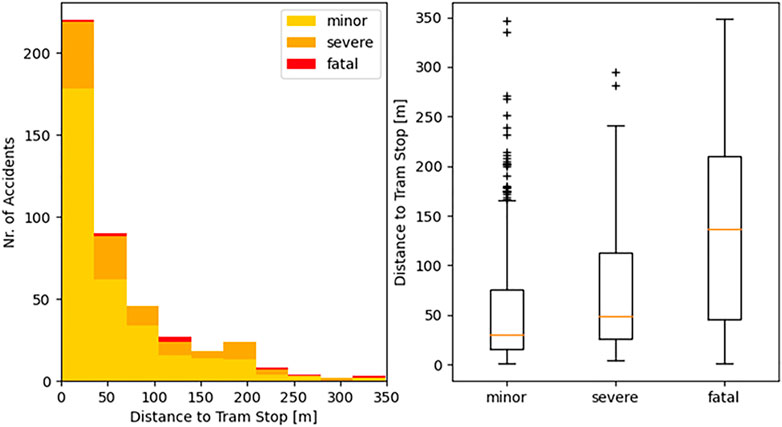
FIGURE 4. Distance distribution between accident-tram stops in the city of Vienna (443 cases during the period 2014–2020), highlighted according to severity.
Tram vs. Pedestrian Accident Collision Speeds
The distribution for the resulting impact speeds for the investigated accident locations in Vienna is shown in Figure 5. The estimated median speed in the cases with minor injuries is 28 km/h and 36 km/h in the severe cases and 30 km/h for both together. The majority of fatal cases happened at a distance with more than 100 m to the next tram stop, where the speed limit was assumed as collision speed, leading to a median value of 50 km/h.
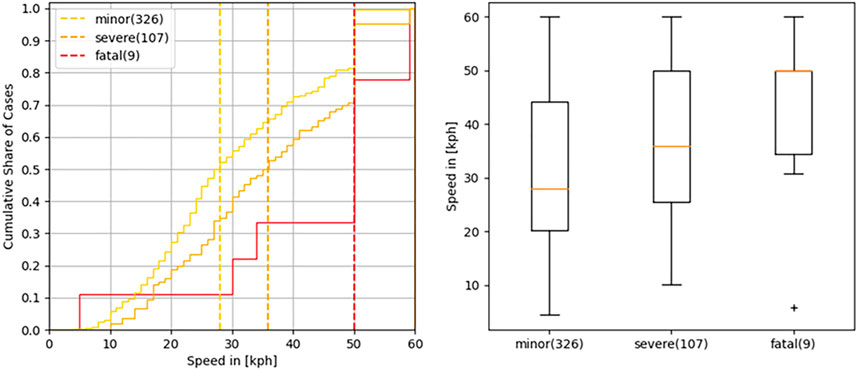
FIGURE 5. Estimated distribution of tram collision speeds for pedestrian accidents in the city of Vienna (443 cases in the period 2014–2020), highlighted according to their severity.
Injured People by Age and Gender
Figure 6 shows accident rates per age and gender group. To obtain representative accident incidences, the absolute accident figures have been divided by the respective number of inhabitants per country and age group. For absolute numbers please see Supplementary Figure SH in the Appendix. Overall, Austria has the highest incidence of tram-pedestrian accidents due to the significantly higher amount of vehicle kilometres travelled. In the Swiss data, the attribute “age” is often missing, therefore only the total number of accidents in Switzerland is shown in Figure 6. Most of the pedestrian accidents per 100,000 persons occur in the age range of 15–24. In Austria and Germany injured pedestrians aged 75 and older, represent the second largest group, whereas in Sweden older pedestrian are not as often involved in tram accidents. In general, the frequency of female and male pedestrians being involved in tram accidents, is similarly. Slight differences between different age-groups were identified for different genders. In Sweden and Germany, slightly more males than females were involved in accidents. In Austria, more accidents involving female pedestrians have been observed in the age groups 15–24 and older than 75, respectively, for Switzerland no further subdivision into age-groups are available.
Detailed Injury Analyses of Swedish Accident Data
Figure 7 shows the share of injuries according to different AIS body regions for AIS2+ and AIS3+ injuries, and as a function of gender, held on the Swedish accident database. For AIS2+ as well as AIS3+ injuries, no significant difference in the distribution of injuries between females and males could be observed for all body regions. Regardless of injury severity, the most frequently injured body region in accidents involving a tram is the head. AIS2+ and AIS3+ are mainly represented by internal organ injuries, e.g., cerebrum, cerebellum and brain stem, and skeletal injuries, e.g., skull fractures, for both female and male pedestrians (Supplementary Appendix Figure SB). Injuries sustained to the thorax, especially for higher injury severities (AIS3+), are highly relevant too. These thorax injuries are mainly represented by internal organ injuries, e.g., lung, heart, hemopneumothorax, pneumothorax, and skeletal injuries, e.g., rip fractures, regardless of injury severity and gender (Supplementary Appendix Figure SD). For AIS3+ injuries, in addition to the head and thorax, injuries to the lower extremities also play an essential role. These injuries are mainly represented by skeletal injuries, e.g., pelvic, femur and tibia fractures, for both females and males (Supplementary Appendix Figure SH). A detailed analysis as a function of anatomical structure, gender and injury severity for pedestrian to tram accidents in Sweden for the remaining body regions, can be found in the Appendix.
Supplementary Figure SA in the Appendix shows the share of injuries for different age groups with respect to AIS2+ and AIS3+ injuries, split in terms of gender based on the Swedish accident database. Regardless of injury severity, injuries are mainly sustained by pedestrians above 25 years, for both females and males. For the age group 50-60YO, females show significant lower odds of sustaining AIS2+ injuries (OR = 0.4, p-value < 0.05) than males. This is also the case for AIS3+ injuries (OR = 0.4, p-value < 0.05). On the other hand, for the age group 65 + YO, females show significantly higher odds of sustaining AIS2+ (OR = 4.8, p-value < 0.05) as well as AIS3+ (OR = 5.6, p-value < 0.05) injuries.
Discussion
At 30%, pedestrians represent the largest group of vulnerable tram collision partners, please see Supplementary Figure SK of the appendix, especially for severe and fatal accidents. In contrast to car occupants, they are more vulnerable to severe injuries in accidents with trams. Therefore, accident prevention and mitigating measures addressing pedestrians should be of high priority for tram and infrastructure developers.
As expected, accident risk is the highest for slight injury which decreases as the injury severity increases. There are slight differences between the accident rates in each city under consideration in this study, which can be attributed to different local conditions (such as types of trams and stops used in each case city, degree of segregation, density of tram network, tram volumes, safety culture, etc.) When interpreting the results and considering their transferability to other cities or countries, we must be mindful of the potential effects of these local conditions.
A conclusive comparison of accident risks for other transport modes, such as personal cars, would require the knowledge of an adequate exposure measure. Cars are spending significant parts of their service life in rural areas and on motorways, while trams almost exclusively move in urban areas, being exposed to pedestrians (such as in city centres, in front of train stations, in pedestrian zones, etc.). Therefore, without an exposure measure, i.e., capturing the exposure of cars to pedestrians, such a comparison is not relevant and conducting such an analysis is also out of scope of this study.
Looking at the figures from the evaluated databases in this study, the most frequently mentioned type of accident location in Switzerland and Sweden is a tram stop. In many cases there is no defined accident location which presents a problem in estimating the impact speed in collisions between pedestrians and trams. Based on the data from Switzerland and the accident investigation in Vienna (Austria), one can only assume that a tram stop is one of the most common accident locations for pedestrians. Perhaps this is due to the source of the data, whereby the accidents in Germany stemming from the police, while the data in Switzerland stem from the Federal Statistical Office and the Swedish data from police reports and hospital databases.
The detailed analysis of tram-pedestrian accidents in Vienna shows that accidents, where minor injuries tend to occur closer to tram stops than accidents resulting in a severe or fatal outcome. This observation seems reasonable since reduced speeds can be expected in the vicinity of stopping areas, which should feasibly lead to reduced injury severity. The presented results certainly benefit from the quantification of the distance, compared to the estimations usually provided in accident reports. This benefit also becomes evident when comparing the different accident configurations in various countries. Thus, it appears difficult to achieve a uniform accident representation, which might also be explainable by the different assessment strategies in different countries.
Under certain circumstances the mapping of the OSM network data with the documented tram stops of the public transport provider “Wiener Linien” sometimes leads to a large distance to the tram network because the nearest stop, determined by the shortest Euclidean distance, is actually not on the actual driven tram route and therefore neglect these cases.
An impact speed distribution figure could be generated by taking various accident site to tram stop distances into account and applying a simplification for the acceleration/deceleration additionally capping the resulting speeds with an upper limit, retrieved from the OSM network. This showed that a tram-pedestrian accident most frequently occurs at impact speeds below 28 km/h for slightly injured and 36 km/h for severely injured pedestrians. However, the respective actual impact speed is always also influenced by the road layout (curve radius), prevailing surrounding traffic, priority rules and a possible emergency braking event before an accident. Compared to this, the average speed of trams in Vienna is approximately 15 km/h, according to official data (Wiener Wiener Linien, 2020) which might be due to the idle times at stops. A detailed analysis of the surrounding traffic and the influence due to emergency braking (Schachner et al., 2020) would be of additional value. The speeds represented in the current paper should be understand as worst-case prediction.
In the recently published Technical Recommendation (TR) 17,420 (Technical Committee CEN/TC, 2019), also 20 km/h are defined as relevant collision speed between trams and pedestrians. However, since according to Figure 5, higher speeds seem to be also relevant for severe and fatal accidents, we suggest assessing safety measures also for higher speeds. At 30 km/h, the majority of slight and sever accidents would be covered.
Regardless of injury severity, the most frequently injured body region in accidents involving a tram is the head. Injuries sustained to the thorax, especially for higher injury severities (AIS3+) are highly relevant too. In addition to AIS3+, injuries to the head and thorax, injuries to the lower extremities also play an essential role.
Injuries are mainly sustained by both male and female pedestrians above the age of 25 years, with no difference in the severity of the injury. For the age group 50-60YO females show significantly lower odds of sustaining AIS2+ injuries than males. This is also the case for AIS3+ injuries. On the other hand, for the age group 65 + YO, females show significantly higher odds of sustaining AIS2+ as well as AIS3+ injuries.
Strengths and Limitations
For the accident risk analysis, the strength of the study lies in the quality of data. Accident data from public transport (PT) providers (CZ), a combined police and hospital database (SWE) and utilised police databases (CHE, AUT) were collected. Although the data is very up-to-date it is still difficult to see whether design improvements in passive safety of trams are having an effect, because there are both old and new vehicles on the tracks due to the long life span of trams, i.e., vehicles older than 30 years are often still in service (Linien, 2022) and (GRAZ Holding, 2022), respectively.
A strength of the present study is that it was possible to combine and compare data cross-nationally. However, simultaneously as only a few parameters could be analysed, making this type of comparison also became a limitation. Although it has been possible to present an overall picture of accidents involving trams in this paper, only subsets of different data sets could be used to carry out detailed analyses, i.e., only Swedish data could be used to analyse injuries. Regrettably, a consistent dataset was not available for the whole dataset. As sample sizes were generally low, as much data as available for each individual research question were used. If only the datasets covering all research questions at once had been used, the resulting dataset would have been too small.
The main limitations include the small sample size of the cases and limited transferability of the results. Furthermore, the injury categories in different hospital databases may have been incorrectly classified in some cases. As the police reporting of accident severity do not necessarily describe the real injury severity, the injury data from emergency hospital departments in Sweden provided an important contribution. It has been possible to provide a comprehensive picture of tram accidents in Sweden, as (virtually) all available data held in STRADA could be included.
Another limitation of this study is that some accidents between pedestrians and trams have not been deemed as road traffic crashes as the traffic is rail-bound. However, questioning the results does not seem to be necessary since the proportion of injured pedestrians is similar across all countries.
In this study, several regional differences were observed. The results of the analysis are very much dependent on infrastructure, as well as the definition of a tram-stop, e.g. radius, etc. in the city under consideration. Infrastructure in Gothenburg, where most tram related accidents in Sweden are recorded, integrates the tram network firmly with the bus network on “ordinary” roads next to other motor traffic. This might be an explanation for the fact that only Sweden showed buses as collision partners for trams.
Additionally, for the analysis of the accident risk, we do not know the number of pedestrians and number of walked kilometres, therefore we have not been able to capture pedestrian activity in our risk calculations.
Outlook
Current tram front design is more and more aligned with pedestrian safety and today’s best practice in this respect is to follow the geometry-based tram front design guidelines of TR 17420 (CEN/TR 17420, 2019). However, analogous to automotive industry, computer simulations will also gain in importance in future tram-relevant standards and, when dealing with computer analyses, appropriate priorities must be set in the development of load cases or the evaluation of results, respectively. Based on the field data analysis presented here, the following recommendations can be made for simulations with Human Body Models (HBMs):
• Safety measures should also be assessed at higher speeds, i.e., up to 30 km/h
• Injury assessment should focus on head and thoracic injuries
• Both, female and male anthropometries should be taken into account in the assessment, taking also the elderly and children into account
• Simulations should be performed with varying impact locations around the vehicle width, as no limitations can be deduced based on available accident data
The predicted injury severities gathered from the simulations can be used as input for cost-benefit analyses (CBAs), to guide engineers and decision makers on future inventions and recommendations. Socio-economic costs and benefits of safety systems are therefore considered, providing insight to the costs of vehicle safety systems, the safety impacts (injuries and quality-of-life loss) and the associated monetary benefits and the socio-economic return (balance of benefits and costs). For such analysis, the crash risk is needed as an input parameter. We recommend using region-specific crash risks, as in the past trams were also designed and sold for specific cities. If a risk assumption on an overall European level is required, or if no regional accident risk is available, the “best estimates” in Table 3 can be used as input for CBA.
Conclusion
Tram accidents involving VRUs are prevalent in urban areas across Europe. The overall average risk for tram pedestrian accidents per million tram kilometres travelled resulting in minor, severe and fatal injuries, is 0.934, 0.448 and 0.063, respectively. The data analysis of accidents involving trams shows that pedestrians clearly account for the largest proportion of fatal injuries, directly followed by cyclists. The various countries in this study show differences in typical tram-pedestrian accident locations though tram stops generally tend to predominate. Regarding the age of pedestrians involved in tram accidents, the accident data show a significant peak for the age group 15–24, however the group older than 75 years also shows a strikingly high involvement. In terms of injured body regions, the head shows the highest rate of AIS2+ and AIS3+ injuries for both males and females.
The analysed data can be used to derive representative virtual testing scenarios, that can be used in the future for utilising the latest analysis techniques, like HBM simulations, to further optimise the pedestrian-safety of trams.
Data Availability Statement
The original contributions presented in the study are included in the article/Supplementary Material, further inquiries can be directed to the corresponding author.
Author Contributions
The main theme for this publication was developed and guided by CK. PK collected tram accident data across Europe. Particularly the Swedish data were collected and analysed by MR. Further accident data and the accident risk analysis are contributed by DB, PP, and RE. MS investigated the Vienna tram accidents in terms of location and impact speed. CLe contributed to the detailed injury analysis of tram accidents in Sweden. AL initiated and coordinated the project funding this study. CLa and PH collated and completed this study with additional evaluations and references. All authors have read and approved the final manuscript.
Funding
This study has been conducted within the VIRTUAL project that has received funding from the European Union Horizon 2020 Research and Innovation Programme under Grant Agreement No. 768960. The overall objective of VIRTUAL is to improve the safety of urban road users by providing procedures and open access tools to assess the benefit of novel safety systems. HBMs of both female and male users are being developed in this project and are now freely available on an open-source basis to facilitate analysis of vulnerable road users’ interaction with public transport systems, e.g., trains, subways, trams, buses, for instance, in great detail.
Conflict of Interest
CL and PH are employed by Siemens Mobility Austria GmbH, PK worked for Siemens Mobility Austria GmbH.
The remaining authors declare that the research was conducted in the absence of any commercial or financial relationships that could be construed as a potential conflict of interest.
Publisher’s Note
All claims expressed in this article are solely those of the authors and do not necessarily represent those of their affiliated organizations, or those of the publisher, the editors and the reviewers. Any product that may be evaluated in this article, or claim that may be made by its manufacturer, is not guaranteed or endorsed by the publisher.
Supplementary Material
The Supplementary Material for this article can be found online at: https://www.frontiersin.org/articles/10.3389/ffutr.2022.913887/full#supplementary-material
References
Barron, C., Neis, P., and Zipf, A. (2014). A Comprehensive Framework for Intrinsic OpenStreetMap Quality Analysis. Trans. GIS 18 (6), 877–895. doi:10.1111/tgis.12073
Bundesgesetzblatt, BGBI (2017). Bundesgesetz über die Statistik zu Straßenverkehrsunfällen mit Personenschaden (Straßenverkehrsunfallstatistik-Gesetz, StVUSt-G) StF. BGBl. I Nr. 7/2017
Bjørnskau, T., and Ingebrigtsen, R. (2015). Alternative Forståelser Av Risiko Og Eksponering. (Alternative Understanding of Risk and Exposure). TØI report 1449/2015. Available at: https://www.toi.no/getfile.php?mmfileid=41817.
BMDW (Bundesministerium für Digitalisierung und Witschaftsstandort) (2018a). Open Data Austria. Vienna: Datenauftritt Stadt Wien. Available at: https://data.wien.gv.at (Accessed January 28, 2022).
BMDW (Bundesministerium für Digitalisierung und Witschaftsstandort) (2018b). Open Data Austria: Katalog Wiener Linien Echtzeitdaten via Datendrehscheibe Wien. Available at: https://www.data.gv.at/katalog/dataset/wiener-linien-echtzeitdaten-via-datendrehscheibe-wien (Accessed January 28, 2022).
Boeing, G. (2017). OSMnx: New Methods for Acquiring, Constructing, Analyzing, and Visualizing Complex Street Networks. Comput. Environ. Urban Syst. 65, 126–139. doi:10.1016/j.compenvurbsys.2017.05.004
Basel Verkehrs-Betriebe, B. V. B (2022). Basler Verkehrsbund. Available at: https://www.bvb.ch/de/unternehmen/geschaeftsbericht/?j=2020 (Accessed February 17, 2022).
Budzyński, M., Szmagliński, J., Jamroz, K., Birr, K., Grulkowski, S., and Wachnicka, J. (2019a). Assessing Tram Infrastructure Safety Using the Example of the City of Gdańsk. J. KONBiN 49, 293–322. doi:10.2478/jok-2019-0060
Budzynski, M., Tubis, A., and Jamroz, K. (2019b). Identifying Selected Tram Transport Risks. IOP Conf. Ser. Mater. Sci. Eng. 603, 042053. doi:10.1088/1757-899X/603/4/042053
Castanier, C., Paran, F., and Delhomme, P. (2012). Risk of Crashing with a Tram: Perceptions of Pedestrians, Cyclists, and Motorists. Transp. Res. Part F Traffic Psychol. Behav. 15, 387–394. doi:10.1016/j.trf.2012.03.001
CEN/TR 17420 (2019). Railway Applications – Vehicle End Design for Trams and Light Rail Vehicles with Respect to Pedestrian Safety. Brussels: Technical Report.
Chevalier, M.-C., Brizard, D., and Beillas, P. (2019). Study of the Possible Relationships between Tramway Front-End Geometry and Pedestrian Injury Risk. Traffic Inj. Prev. 20, 107–113. doi:10.1080/15389588.2018.1536823
Corcoran, P., Mooney, P., and Bertolotto, M. (2013). Analysing the Growth of OpenStreetMap Networks. Spat. Stat. 3, 21–32. doi:10.1016/j.spasta.2013.01.002
COST (2015). Operation and Safety of Tramways in Interaction with Public Space. Available at: https://www.cerema.fr/system/files/documents/2019/04/tu1103_report_red.pdf (Accessed February 9, 2022).
Currie, G., and Shalaby, A. (2007). Success and Challenges in Modernizing Streetcar Systems: Experiences in Melbourne, Australia, and Toronto, Canada. Transp. Res. Rec. 2006, 31–39. doi:10.3141/2006-04
Currie, G., Tivendale, K., and Scott, R. (2011). Analysis and Mitigation of Safety Issues at Curbside Tram Stops. Transp. Res. Rec. 2219, 20–29. doi:10.3141/2219-03
DPP – Prague Public Transit Company (2020). Main Causes of Tram-Pedestrian Accidents. Available at: https://www.neskakejmipodkola.cz/#priciny (Accessed February 9, 2022).
Elvik, R. (2015). Some Implications of an Event-Based Definition of Exposure to the Risk of Road Accident. Accid. Analysis Prev. 76, 15–24. doi:10.1016/j.aap.2014.12.011
European Union (2021). Eurostat. Available at: ec.europa.eu/eurostat (Accessed November 11, 2021).
Federal Statistical Office of Germany (2021). DESTATIS. Available at: https://www-genesis.destatis.de/genesis/online (Accessed November 11, 2021).
Gaca, S., and Franek, L. (2021). Pedestrian Fatality Risk as a Function of Tram Impact Speed. Open Eng. 11, 1105–1113. doi:10.1515/eng-2021-0110
Girres, J.-F., and Touya, G. (2010). Quality Assessment of the French OpenStreetMap Dataset. Trans. GIS 14 (4), 435–459. doi:10.1111/j.1467-9671.2010.01203.x
Göteborgs Stad (2022). Göteborgs Stad. Available at: https://www4.goteborg.se/prod/intraservice/namndhandlingar/samrumportal.nsf (Accessed February 17, 2022).
Graz Holding (2022). FAQs zu den Graz Linien. Available at: https://www.holding-graz.at/de/mobilitaet/faq/(Accessed February 17, 2022).
Grzebieta, R. H., and Rechnitzer, G. (2000). Tram Interface Crashworthiness. ICrash 2000 - International Crashworthiness Conference. London: The Royal Aeronautical Society.
Guerrieri, M. (2018). Tramways in Urban Areas: An Overview on Safety at Road Intersections. Urban Rail Transit 4, 223–233. doi:10.1007/s40864-018-0093-5
Hakkert, A. S., and Braimaister, L. (2002). The Uses of Exposure and Risk in Road Safety Studies. Netherlands: SWOV Institute for Road Safety Research.
Haklay, M. (2010). How Good Is Volunteered Geographical Information? A Comparative Study of OpenStreetMap and Ordnance Survey Datasets. Environ. Plann B Plann Des. 37 (4), 682–703. doi:10.1068/b35097
Haklay, M. (2014). Crowdsourced Geographic Information Use in Government. London: World Bank Publications.
Hedelin, A., Björnstig, U., and Brismar, B. (1996). Trams-a Risk Factor for Pedestrians. Accid. Analysis Prev. 28, 733–738. doi:10.1016/s0001-4575(96)00048-6
Hedelin, A., Bunketorp, O., and Björnstig, U. (2002). Public Transport in Metropolitan Areas - a Danger for Unprotected Road Users. Saf. Sci. 40, 467–477. doi:10.1016/s0925-7535(01)00014-5
Howard, C., and Linder, A. (2014). Review of Swedish Experiences Concerning Analysis of People Injured in Traffic accidentsVTI Notat 7A-2014. Linköping: National Road and Transport Research Institute VTI.
Innsbrucker Verkehrsbetriebe (2022). Innsbrucker Verkehrsbetriebe und Stubaitalbahn GmbH. Available at: https://www.ivb.at/unternehmen/ueber-uns/(Accessed February 17, 2022).
Kruszyna, M., and Rychlewski, J. (2013). Influence of Approaching Tram on Behaviour of Pedestrians in Signalised Crosswalks in Poland. Accid. Analysis Prev. 55, 185–191. doi:10.1016/j.aap.2013.03.015
Margaritis, D. (2007). Accident Analysis into the Primary and Secondary Safety of City Trams in the Netherlands. Leiden: Association for European Transport and contributors. European Transport Conference.
Mattsson, K., and Ungerbäck, A. (2013). Vägtrafikolyckor: Handledning Vid Rapportering. Borlänge: Transportstyrelsen.
MVG (2009). The Modern Tram in Europe. Available at: http://www.reconnectingamerica.org/assets/Uploads/The-Modern-Tram-in-Europe.pdf (Accessed February 9, 2022).
Naweed, A., and Rose, J. (2015). "It's a Frightful Scenario": A Study of Tram Collisions on a Mixed-Traffic Environment in an Australian Metropolitan Setting*. Procedia Manuf. 3, 2706–2713. doi:10.1016/j.promfg.2015.07.666
Naznin, F., Currie, G., Logan, D., and Sarvi, M. (2016a). Safety Impacts Of Platform Tram Stops On Pedestrians In Mixed Traffic Operation: A Comparison Group Before–After Crash Study. Accid. Analysis Prev. 86, 1–8. doi:10.1016/j.aap.2015.10.007
Naznin, F., Currie, G., and Logan, D. (2016b). Exploring the Impacts of Factors Contributing to Tram-Involved Serious Injury Crashes on Melbourne Tram Routes. Accid. Analysis Prev. 94, 238–244. doi:10.1016/j.aap.2016.06.008
Naznin, F., Currie, G., and Logan, D. (2017). Key Challenges in Tram/streetcar Driving from the Tram Driver's Perspective - A Qualitative Study. Transp. Res. Part F Traffic Psychol. Behav. 49, 39–48. doi:10.1016/j.trf.2017.06.003
OSM Wiki (OpenStreetMap Wiki contributors) (2020). Austria/Nahverkehr Wien. Available at: https://wiki.openstreetmap.org/wiki/Austria/Nahverkehr_Wien#Stra.C3.9Fenbahnlinien (Accessed January 28, 2022).
Peng, F., Zhao, Y., Chen, T., Zhang, X., Chen, W., Zhou, D., et al. (2018). Development of Robust Suboptimal Real-Time Power Sharing Strategy for Modern Fuel Cell Based Hybrid Tramways Considering Operational Uncertainties and Performance Degradation. Appl. energy 226, 503–521. doi:10.1016/j.apenergy.2018.05.092
Stadtwerke Saarbrücken, S. (2018). Zahlenspiegel 2018. Saarbrücken: Stadtwerke Saarbrücken Holding GmbH.
Sagberg, F., and Sætermo, I. E. (1997). Traffic Safety of Tram Transport. TØI Report 367. Available at: https://www.toi.no/getfile.php/138906-1208933888/Publikasjoner/T%C3%98I%20rapporter/1997/367-1997/sum-367-97.pdf (Accessed February 9, 2022).
Schachner, M., Sinz, W., Thomson, R., and Klug, C. (2020). Development and Evaluation of Potential Accident Scenarios Involving Pedestrians and AEB-Equipped Vehicles to Demonstrate the Efficiency of an Enhanced Open-Source Simulation Framework. Accid. Analysis Prev. 148, 105831. doi:10.1016/j.aap.2020.105831
Špirk, S. (2021). Utilization of the Validated Windshield Material Model in Simulation of Tram to Pedestrian Collision. Materials 14, 265. doi:10.3390/ma14020265
Städtische Verkehrsbetriebe Bern (2022). Bernmobil - Fahrgastzahlen. Available at: https://geschaeftsbericht.bernmobil.ch/de/zahlen-und-fakten/bernmobil-in-zahlen/?oid=68&lang=de#fahrzeuge (Accessed on February 17, 2022).
Swedish Government Offices (1965). Health in Offices and Shops 1965. Br. Med. J. 2, 1130–1131. doi:10.1136/bmj.2.5470.1130-a
Technical Committee CEN/TC (2019). Railway Applications - Vehicle End Design for Trams and Light Rail Vehicles with Respect to Pedestrian Safety. Brussels: European Committee for Standardization, 30.
Transports publics genevois (2022). Transports Publics Genevois. Available at: https://www.tpg.ch/fr/rapports-annuels (Accessed February 17, 2022).
TSK Praha (2022). Technická Správa Komunikací Hlavního Města Prahy. Available at: https://www.tsk-praha.cz/wps/portal/root/nabidka-sluzeb/rocenky (Accessed on February 17, 2022).
UIC: International union of Railways (2009). UIC: International Union of Railways. France: ERRAC Road Map.
UITP : International Association of Public Transport (2019). Public Transport Trend 2019. Available at: https://cms.uitp.org/wp/wp-content/uploads/2020/06/PT_Trends2019_Executive_Summary.pdf (Accessed February 9, 2022).
Verkehrsbetriebe Karlsruhe, V. B. K. (2020). Die VBK in Zahlen. Karlsruhe: Verkehrsbetriebe Karlsruhe GmbH.
Verkehrsbetriebe Zürich, V. B. Z. (2020). Fahrleistungen. Available at: https://www.stadt-zuerich.ch/vbz/de/index/die_vbz/portraet/zahlen_fakten/angebot.html (Accessed on February 17, 2022).
Verkehrsbetrieb Potsdam, S. (2015). Zahlen und Fakten. Verkehrsbetrieb Potsdam GmbH ViP. Available at: https://web.archive.org/web/20150424002625/http:/www.swp-potsdam.de/swp/de/verkehr/ueber-uns-vip/zahlen_und_fakten-vip/zahlen_und_fakten.php (Accessed April 27, 2022).
Verkehrsverbund, O. Ö. (2022). Stadtverkehr. VBB Susanne Henckel. Available at: https://www.ooevv.at/?seite=stadtverkehr&sprache=DE (Accessed February 17, 2022).
Wiener Linien (2020). Betriebsangaben. Available at: https://www.wienerlinien.at/media/files/2020/wl_betriebsangaben_2019_deutsch_358274.pdf (Accessed February 21, 2022).
Wiener Linien, W. (2021). Description of the OGD Files for the Data Platform of the Wiener Linien. Available at: https://www.wienerlinien.at/ogd_realtime/doku/ogd/wienerlinien_ogd_Beschreibung.pdf (Accessed February 21, 2022).
Keywords: Tram, public transport, pedestrian, injury severity, accident, injuries
Citation: Lackner C, Heinzl P, Rizzi MC, Leo C, Schachner M, Pokorny P, Klager P, Buetzer D, Elvik R, Linder A and Klug C (2022) Tram to Pedestrian Collisions—Priorities and Potentials. Front. Future Transp. 3:913887. doi: 10.3389/ffutr.2022.913887
Received: 06 April 2022; Accepted: 11 May 2022;
Published: 22 June 2022.
Edited by:
Yong Han, Xiamen University of Technology, ChinaReviewed by:
Guibing Li, Hunan University of Science and Technology, ChinaGeorge Yannis, National Technical University of Athens, Greece
Copyright © 2022 Lackner, Heinzl, Rizzi, Leo, Schachner, Pokorny, Klager, Buetzer, Elvik, Linder and Klug. This is an open-access article distributed under the terms of the Creative Commons Attribution License (CC BY). The use, distribution or reproduction in other forums is permitted, provided the original author(s) and the copyright owner(s) are credited and that the original publication in this journal is cited, in accordance with accepted academic practice. No use, distribution or reproduction is permitted which does not comply with these terms.
*Correspondence: Christian Lackner, bGFja25lci5jaHJpc3RpYW5Ac2llbWVucy5jb20=
 Christian Lackner
Christian Lackner Philipp Heinzl1
Philipp Heinzl1 Maria C. Rizzi
Maria C. Rizzi Christoph Leo
Christoph Leo Martin Schachner
Martin Schachner Petr Pokorny
Petr Pokorny Astrid Linder
Astrid Linder Corina Klug
Corina Klug